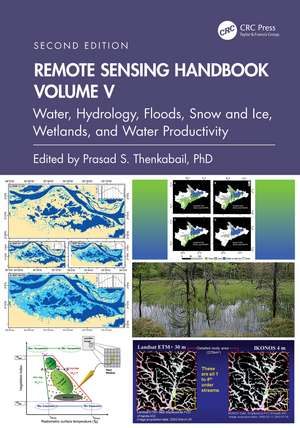Remote Sensing Handbook, Volume V: Water, Hydrology, Floods, Snow and Ice, Wetlands, and Water Productivity: Remote Sensing Handbook
Editat de Prasad S. Thenkabailen Limba Engleză Hardback – 29 noi 2024
FEATURES
- Provides the most up-to-date comprehensive coverage of remote sensing science for water resources, including wetlands, floods, snow, and ice.
- Provides comprehensive assessments of crop water use and crop water productivity modeling and mapping, including evapotranspiration studies.
- Discusses and analyzes data from old and new generation of satellites and sensors spread across 60 years.
- Includes numerous case studies on advances and applications at local, regional, and global scales.
- Introduces advanced methods in remote sensing, such as machine learning, cloud computing, and artificial intelligence (AI).
- Highlights scientific achievements over the last decade and provides guidance for future developments.
Preț: 1134.44 lei
Preț vechi: 1383.46 lei
-18% Nou
Puncte Express: 1702
Preț estimativ în valută:
217.10€ • 225.37$ • 181.03£
217.10€ • 225.37$ • 181.03£
Carte tipărită la comandă
Livrare economică 24 martie-07 aprilie
Preluare comenzi: 021 569.72.76
Specificații
ISBN-13: 9781032891453
ISBN-10: 1032891459
Pagini: 554
Ilustrații: 366
Dimensiuni: 178 x 254 mm
Greutate: 1.18 kg
Ediția:2
Editura: CRC Press
Colecția CRC Press
Seria Remote Sensing Handbook
ISBN-10: 1032891459
Pagini: 554
Ilustrații: 366
Dimensiuni: 178 x 254 mm
Greutate: 1.18 kg
Ediția:2
Editura: CRC Press
Colecția CRC Press
Seria Remote Sensing Handbook
Public țintă
Postgraduate, Professional Reference, and Undergraduate AdvancedCuprins
Part I: Geomorphology. 1. Geomorphological Studies from Remote Sensing. Part II: Hydrology and Water Resources. 2. Remote Sensing Technologies for Multi-scale Hydrological Studies: Advances and Perspectives. 3. Groundwater Targeting Using Remote Sensing. Part III: Floods. 4. Flood Monitoring using the Integration of Remote Sensing and Complementary Techniques. 5. Flood Studies using Synthetic Aperture Radar Data. 6. Remote Sensing of Mangrove Forests. Part IV: Wetlands. 7. Remote Sensing of Mangrove Wetlands. 8. Wetland Mapping Methods and Techniques Using Multi-Sensor, Multi-Resolution Remote Sensing: Successes and Challenges. 9. Inland Valley Wetland Cultivation and Preservation for Africa’s Green and Blue Revolution using Multi-Sensor Remote Sensing. Part V: Water Use and Water Productivity. 10. Remote Sensing of Evapotranspiration from Croplands. 11. Modeling and Monitoring Water Productivity by Using Geotechnologies: Assessments in some Brazilian Agroecosystems. Part VI: Snow and Ice. 12. Remote Sensing Mapping and Modeling of Snow Cover Parameters and Applications. Part VII: Summary and Synthesis for Volume V. 13. Remote Sensing Handbook, Volume V: Water Resources, Hydrology, Floods, Snow and Ice, Wetlands, and Water Productivity.
Notă biografică
Dr. Prasad S. Thenkabail, Senior Scientist (ST), United States Geological Survey (USGS), is a world-recognized expert in remote sensing science with major contributions in the field for nearly 40 years. He has made the list of the world’s top 1% of scientists across 22 scientific fields and 176 sub-fields. Dr. Thenkabail has conducted pioneering research in hyperspectral remote sensing of vegetation, global croplands, and their water use for food security. He obtained his PhD from the Ohio State University in 1992 and has 168 peer-reviewed publications including 15 books, including this six-volume set, and over 15 major data releases such as the Landsat-derived global cropland extent product @ 30m and Landsat-derived rainfed and irrigated cropland area product @ 30 m (LGRIP30). He was recognized as a Fellow of the American Society of Photogrammetry and Remote Sensing (ASPRS) in 2023. His scientific papers have won several awards for demonstrating world-class, highest-quality research. He was a Landsat Science Team Member (2007-2011).
Descriere
Volume V of the Remote Sensing Handbook, Second Edition, is focused on the use of remote sensing technologies for studying water resources including groundwater, floods, snow and ice, and wetlands. This book provides an essential resource for researchers at all levels interested in using remote sensing.









